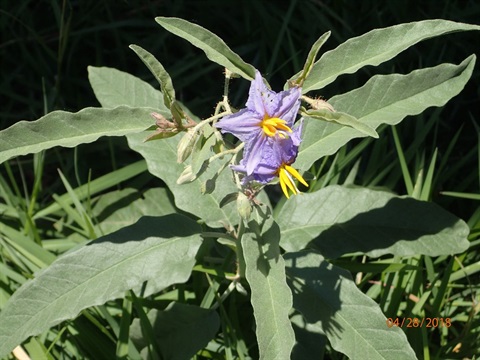
It's week eight of Council's Weed of the Week series for the 2024/25 spring and summer season. This series of articles provides our community with information and advice on new, emerging and established invasive plant species threatening our region.
Whether you're living on the land, living in town, or just passing through – we all have a part to play in protecting our natural environment and agricultural land from invasive plants and weeds.
This week we look at silverleaf nightshade (Solanum elaeagnifolium). Silverleaf nightshade is a Weed of National Significance and is prohibited from being sold, bartered, exchanged or offered for sale anywhere in the state of New South Wales.
The plant is drought tolerant, favouring areas with an average rainfall of 300–560mm. It grows upright year-round and ranges from 10cm to 1m in height, with prickly stems and silvery hair-covered stems and leaves. Leaves have wavy edges and can grow up to 15cm long and 0.5 to 2.5cm wide.
Flowers grow in a star shape with five petals. Colouration ranges from blue, through pale lavender to white. The inside of the flower contains yellow stamens (the small thin bits inside flowers with pollen balls at their top). The plant produces toxic berries that last through winter, with colourations proceeding through green to yellow to orange to red and finally brown.
Silverleaf nightshade is spread by root pieces and seed. All parts of the root are capable of forming shoot buds. It is one of the most difficult weeds to kill and displays allelopathic qualities, impeding the germination and growth of plants around it.
Where is silverleaf nightshade found?
Silver leaf nightshade has established in areas west of the Great Dividing Range, though only exists at isolated sites east of the range. It is recorded on one property within the Snowy Monaro region and is actively managed with the objective of eradication.
Eradicating such a weed threat in its early stages of invasion provides significantly greater return on investment than trying to manage a well-established weed. For this reason Council calls on community members to learn how to identify this species and immediately report suspect incursions to Council's Biosecurity team on 1300 345 345.
Silverleaf nightshade can:
- Significantly reduce summer crop yields through direct competition
- Reduce winter crop yields by depleting soil moisture
- Invade pasture and reduce sub-clover growth
- Reduce annual pasture growth in autumn and winter
- Poison stock if they eat ripe berries
- Be expensive to control
- Spread easily though both seeds and tiny plant fragments
What must you do if you detect silverleaf nightshade on your land?
Due to its isolated occurrence in south-eastern NSW and its impact on the economy, environment and community, the South East Regional Strategic Weed Management Plan 2023–2027 specifies that silverleaf nightshade should be eradicated. This objective applies to all land within the Snowy Monaro region.
What can you do?
- Learn to identify silverleaf nightshade and notify Council's biosecurity team immediately if you suspect its presence
- If introducing stock onto your land, hold them in a controlled and observable space for two weeks before moving them into clean pasture
- Clean machinery
- Carefully consider where you source hay, grain and other supplies
- Limit the number of feed-out areas and monitor them closely
- Consider weed risk when agisting stock on or off your property
- Maintain strong, competitive pastures to help suppress weed seedlings
- Do not let livestock eat fruiting plants
Council is here to help. If you have questions about silverleaf nightshade, or any other weeds – contact our specialist biosecurity officers for advice and assistance. Our staff provide a free, onsite weed identification and advisory service.






